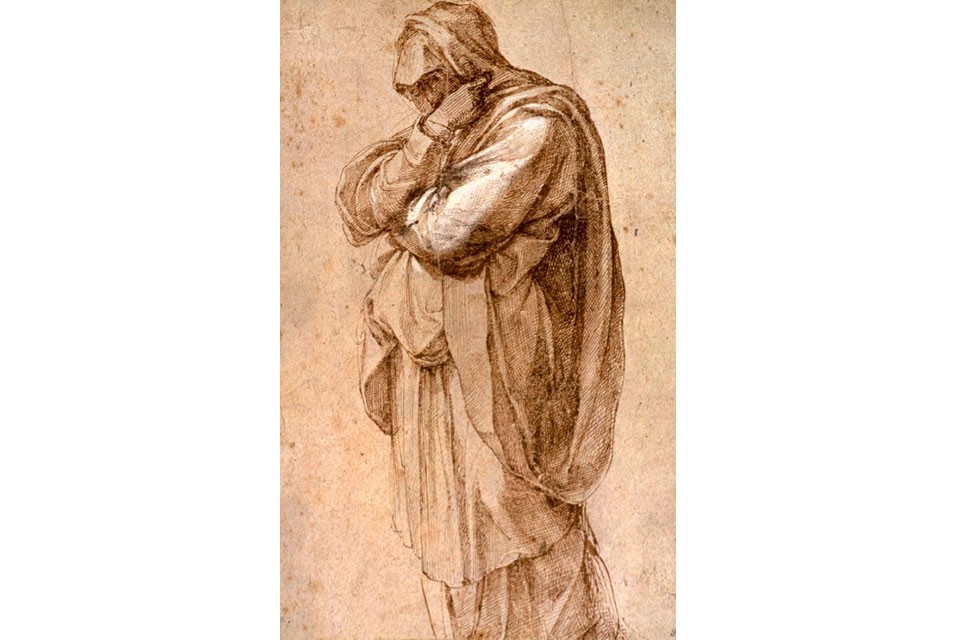- Image may be NSFW.
Clik here to view.
La Surprise, ca. 1718, Jean Antoine Watteau (French, 1684 – 1721). Oil on panel. 36.3 x 28.2 cm. The J. Paul Getty Museum, Los Angeles
In July 2017, the J. Paul Getty Museum announced one of the most important acquisitions in its history: sixteen major drawings and an exquisite painting by Jean Antoine Watteau. Michelangelo to Degas: Major New Acquisitions, presents these newly acquired works to the public from January 17–April 22, 2018 at the J. Paul Getty Museum at the Getty Center.
“This latest acquisition has been the most transformative ever in the history of the Department of Drawings, bringing into the collection a number of extremely rare masterpieces by some of the greatest artists of the Renaissance through the 19th century,” says Timothy Potts, director of the J. Paul Getty Museum. “Showcasing these works together will demonstrate the monumental nature of this purchase, which also includes a famous painting by the French artist Jean Antoine Watteau. It is increasingly rare to be able to acquire masterpieces of this stature, which have been highly sought after by connoisseurs since the 16th century, and by now have long been swept up by museums.”
With a particularly strong group of rare Italian Renaissance sheets, the acquisition features exceptional works by many of the most celebrated draftsmen in the history of European art, including Michelangelo, Lorenzo di Credi, Parmigianino, Andrea del Sarto, Domenico Tiepolo, Goya, and Degas.
Image may be NSFW.
Clik here to view.
Clik here to view.

Study of a Mourning Woman, ca. 1500-05, Michelangelo Buonarroti (Italian, 1475-1564). Pen and brown ink, heightened with white. 26 x 16.5 cm. The J. Paul Getty Museum, Los Angeles
Highlights include Michelangelo’s Study of a Mourning Woman (about 1500-1505), a celebrated drawing of a mourning figure, with her face semi-hidden. Michelangelo made the work at a pivotal moment early in his career when, already renowned as a sculptor, he became increasingly esteemed as a painter. The drawing was discovered pasted into an album in the library at Castle Howard, England in 1995.
Image may be NSFW.
Clik here to view.

The Head of a Young Man (about 1539-40), made toward the end of Parmigianino’s short life when he was at the peak of his artistic mastery, is one of his most famous drawings. Working in pen and ink on an under-lifesize scale with absolute precision and control of line, Parmigianino yields an astonishing impression of the sitter, who was probably a studio assistant. The influence of classical portrait busts on this jewel of a drawing is apparent in the gaze of the eyes and the sense of delicate perfection.
Parmigianino, "Head of a Young Man," circa 1539-40, ink (Getty Museum)
Degas is represented by two exceptional, complementary works. Two Studies of Dancers (about 1873), a superbly-preserved preparatory drawing on green paper, captures two dancers as one extends her leg and the other looks down, while strokes of white chalk indicate light streaming in from an unseen source. After the Bath (Woman Drying Herself) (about 1886) is a magnificent, large pastel of a nude in a densely patterned, dizzily colorful interior, made when the artist had all but ceased to exhibit, retreating into his studio to produce increasingly bold, experimental work.
“To be able to share any one of these drawings with our visitors would be an extraordinary privilege, but to add a group such as this to the collection, and to exhibit them together, is beyond a dream,” said Julian Brooks, senior curator of drawings.
Image may be NSFW.
Clik here to view.

The exhibition also includes one of Jean Antoine Watteau’s finest paintings, La Surprise (The Surprise), painted in 1718-19. Watteau created and defined the genre of the fěte galante, evocative outdoor scenes of romantic encounters and entertainment, which embodies the light-hearted spirit of French painting in the early eighteenth century. Thought to have been lost for centuries, and only known to historians from a 1731 engraving and copy in the British Royal Collection, this painting was rediscovered in 2007. At the Getty, it joins other exceptional eighteenth-century French paintings by Lancret, Chardin, Greuze, Fragonard, and Boucher.
Michelangelo to Degas: Major New Acquisitions will be on view January 17-April 22, 2018, at the J. Paul Getty Museum. The exhibition is curated by Julian Brooks, senior curator of drawings at the J. Paul Getty Museum.
Excellent review, more images,video
